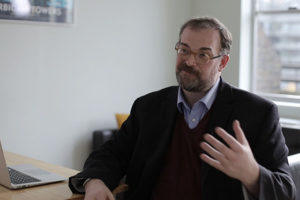Importance of Nomads in Eurasian History
Historian Thomas Barfield on the Xiongnu empire, Genghis Khan, and the Mongolian tax policy
In which ways was statistics used by the Soviet government? How did existing statistical data contradict the state’s objectives and expectations? What were the consequences of secrecy policies? These and other questions are answered by Alain Blum, Director of studies at EHESS and Research Director at INED.
For Bolsheviks, especially beginning from Stalin’s period, statistics was not only a tool to manage society and economy. It was a tool to orientate, give an objective to economy even if this objective was not realistic. But also, it was a tool of propaganda. Statistics was a tool to demonstrate that the orientation of the Soviet Union was good and that the situation was good. Statistics was a tool to develop this propaganda. Then, of course, because of the discrepancy of what was observed and what was said, very quickly after the collectivization, which was maybe the greatest failure of this state, there began conflicts between statisticians and the political pole. The political pole disagreed with the figures, which demonstrated the failure. The most important example is when statisticians discovered the famine in Ukraine. What could they do? They presented the figures; they didn’t speak about the famine because it was forbidden but they presented the figures, which were the proof of the failure of all this period – the catastrophe of the famine. After that, in 1937, for example, they did a census and that census demonstrated this failure again. Of course, the results of the census were not accepted by Stalin and it was a beginning of a great purge in statistician apparatus because, for Stalin, the bad figures presented in the census was not the result of reality but the result of bad work of statisticians.
During Khrushchev-Brezhnev period, statistics continue to be very important because of the importance of the plan and because of scientific governmentality. Again, statistics is done to show not the reality, but the good results. Then there is the development of secrecy, which is completely contradictory to the idea of statistics to be used to change society. There is big secrecy around all statistical data: good data can be presented, bad data has not to be presented to the population. Because there are many problems in the society, statistics show these problems. They show, for example, the growth of abortion, the growth of mortality, beginning in the 1960s, and they show many other problems, which are being developed in the society and which demonstrate the failure of the social development of the 1960-1970s. For example, there is an increase of suicides, which is a consequence of alcoholism. In the small world of statisticians, who are specialists in this question, everything is well-known. They discuss the problem among themselves and send reports to the Central Committee saying, “Be aware that there is an increase of mortality, that alcoholism is very hard.” But there are no public discussions; all these figures are hidden and constrained by the rule of secrecy.
It’s well-known that when there is a social problem, the only way to solve it is to discuss it openly. Statistics could be very useful if there is no secrecy involved. But because of secrecy and because the discussions are so closed in a small milieu, it has no effect on population and mortality continues. There are no means to stop social problems because they are not discussed in the society. It shows how statistics can be a way to manage society but also – because it’s considered as a way of propaganda, because of the discrepancy between what the state wants to show to population and what the real situation is – that the consequence is that the failure is becoming more important. We can see it again now; there is such a problem in Russia because there are discussions about the decrease of population and the problem of mortality, which is now, however, better. But these discussions are now very politicized whereas there have to be very open social discussions. Again, the tension between the two aspects of statistics – the tool of government and the tool of knowledge – appear to be very important.

Historian Thomas Barfield on the Xiongnu empire, Genghis Khan, and the Mongolian tax policy

Historian of Science Simon Werret on the Russian maritime empire, sale of Alaska, and the role of trade in rec...

Historian Paul Gregory on the agrarian crisis hypothesis, smychka, and the agricultural performance of Siberia